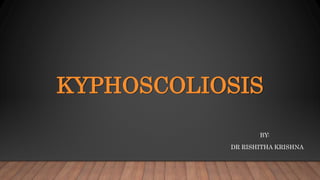Kyphoscoliosis
- 2. DEFINATION âĒ Kyphoscoliosis is an abnormal curve of the spine on two planes: the coronal plane or the side to side and the saggital plane or back to front. âĒ Itâs a combined spinal abnormality of two other conditions: kyphosis and scoliosis. âĒ Scoliosis causes the spine to curve abnormally on the coronal plane, meaning it twists sideways. âĒ Kyphosis causes the spine to curve abnormally on the saggital plane, meaning it twists forward or backwards, similar to a hunchback.
- 3. CAUSES âĒ This condition can occur at any age, including at birth. âĒ 80% of cases are idiopathic. âĒ Spinal condition is a result of I. PROLONGED BAD POSTURE: Poor posture over time may result in postural kyphoscoliosis. It can be treated with extensive physical therapy. II. TUBERCULOSIS(TB): TB can weaken the spine. III. OSTEOCHONDRODYSPLASIA: This is a type of skeletal dysplasia, a condition that impairs the growth of spinal bones, cartilage, and connective tissue. IV. DEGENERATIVE DISEASES: Examples include osteoporosis and osteoarthritis(OA)
- 4. SYMPTOMS âĒ Hunched back or uneven back âĒ Uneven shoulder blades âĒ Arms or legs longer on one side âĒ Body image issues MORE SEVERE SYMPTOMS âĒ Disfigurement âĒ Back pain âĒ Trouble breathing âĒ Weakness or paralysis âĒ Stiffness âĒ Fatigue âĒ Neurological issues âĒ Heart issues
- 5. 5 KYPHOSCOLIOSIS TREATMENT MWTHODS I. CHECK-UPS; Early detection of spine problems is a key to preventing your condition from getting worse. II. SCOLIOSIS BRACING; As an alternative to surgery, doctors may recommend using a back brace. Bracing isnât an effective treatment method for adults whose bones have stopped growing. Bracing wonât cure it but can prevent any future damage. Typically worn throughout the day. III. PAIN MANAGEMENT; Doctors may recommend cortisone injections and other pain medication to help provide temporary relief. IV. PHYSICAL THERAPY; Active physical therapy involves exercises that increase spine strength and flexibility. V. SURGERY; Surgical corrections; common option, spinal fusion. Itâs a procedure with metal rods or screws to prevent independent movement. This allows old and an new spinal material to form together.




